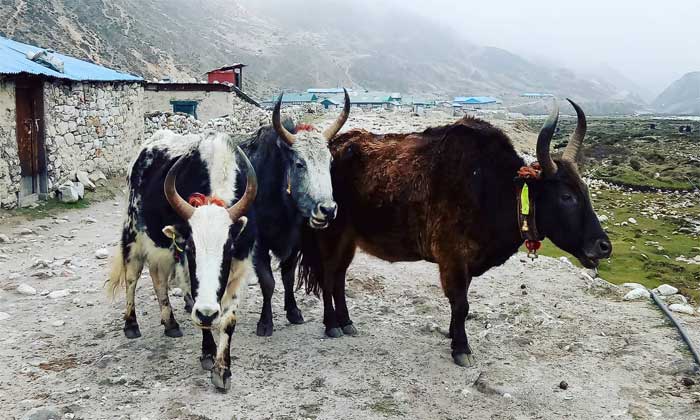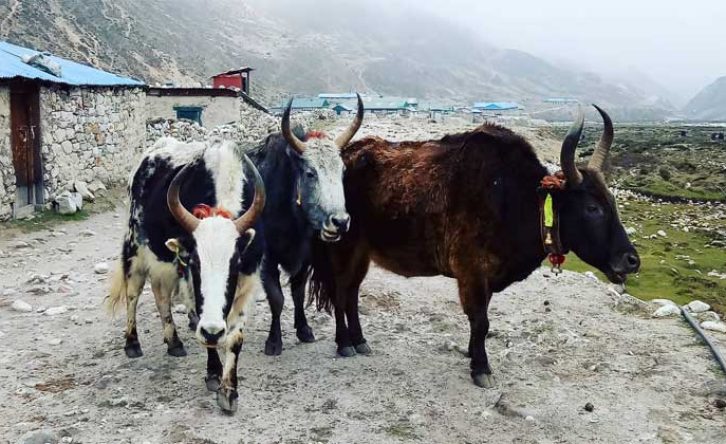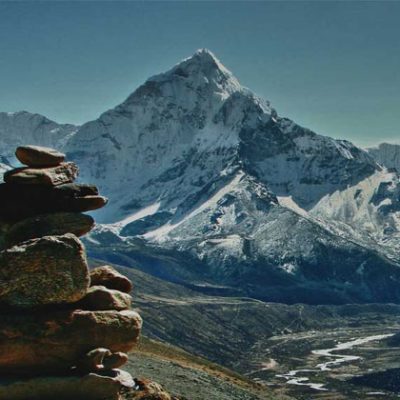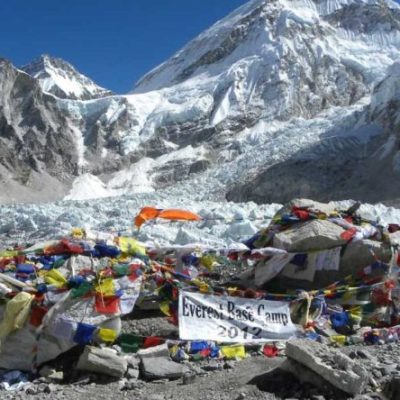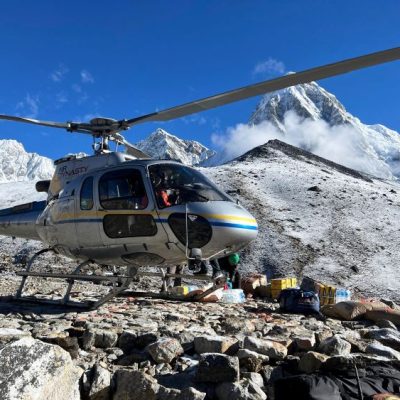Overview
Everest Base camp Trek from Phaplu ( Drive Inn, Fly out)
Phaplu to Everest Base Camp Trek is Classics route to Everest base camp which drive 8, 9 hour from Kathmandu. It is an alternative safe trekking route than taking to 40 minute lukla flight. The Everest Base Camp Trek from Phaplu is an exciting, off-the-beaten trek in the foothills of the Himalayas. The trek diverts away from the well-trodden path of Lukla to Everest Base Camp and passes through isolated landscapes and far off settlements. The fantastic views of the snow-capped mountains will follow you all along the trail.
EBC Trek by road from Phaplu is The beautiful trekking journey lets you explore the virgin lands, giving you a new perspective of the Everest region. You can explore the ethnic Sherpa culture and the Buddhist heritage along the trail. Hiker can find small chortens, Mani stone wall, and Buddhist blessings and prayer flags all over the trail.
You will walk along narrow canyons paths gorged by the pristine white water rivers of the region. The trekking journey also passes through the UNESCO listed natural World Heritage Site of Sagarmatha National Park. We start our trek from Salleri on a quiet and pleasant trail as the route leads to Takshindo-La pass that provides awe-inspiring views of Numbur and Khumbu Himal.
The downhill walk runs along the banks of the Dudh Kosi River past Nunthala village and then climbs up towards Kharkhola and Bupsa hilltop. The route then passes through a forest at Surkhe and finally arrives at Phakding. The trek differs significantly from the regular trail of Lukla to Everest Base Camp.
It starts on a relatively unknown landscape passing through scattered settlements and tranquil environments before converging with the regular trail at Phakding. The Everest Base Camp Trek from Salieri gives you an added value of adventure of the Solukhumbu region and lets you explore some of the unknown parts of the region.
So, are you ready to experience one of the least traveled alternative trekking routes in the Himalayas? If your answer is yes, then you must take the Phaplu to Everest Base Camp trek. We are offering this adventurous tour package at a reasonable cost. So, what are you waiting for? Book your trip now!
Why Everest base Camp Trek from Phaplu
- Trekking in the off-the-beaten, hidden route of the Everest region
- It is best option to go Everest Base camp by foot from Phaplu. Your trip will be 100 % guaranty, No need to worry about the Cancel your Lukla flight
- Scenic drive to Phaplu and adventurous mountain flight from Lukla
- Experiencing the most beautiful sunrise on the backdrop of the snow-capped mountains in Kala Patthar
- Exploring the Sherpa villages and the culture and lifestyle of the sherpa community
- Breathtaking views of the snow-capped mountains, including Mt. Everest, Ama Dablam, Lhotse, Nuptse, Taboche, Cholatse, Pumori, and others
- Spotting wildlife including Musk Deer, Himalayan Thar, Snow Leopard, among others
- Incredible hospitality of the local people
Planning to Trek Phaplu to Everest Base Camp, But Not Sure When?
The trek is doable all round the year, but the best time for the trek from Salleri to Everest Base Camp is the Autumn season (September- November) and the Spring season (March- May).
Autumn (September-November)
The Autumn season is the peak season for trekking in Nepal. The weather is perfect, and the daytime temperatures are ideal for trekking.
The autumn season comes after the monsoon, which means there are fewer chances of precipitation. The clear blue skies provide unobstructed views of the beautiful snow-capped mountains.
Spring (March-May)
If you want to trek in a beautiful environment with perfect trekking conditions, then the spring season is ideal for you. The wildflowers, especially the rhododendron bloom all over the hills painting the hills pink and red.
There are lesser risks of precipitation, and the breathtaking views of the snow-capped mountains are guaranteed in the spring season.
If you are someone who loves trekking in a peaceful environment, then you might try out the off-season treks, but trekking in the offseason has a lot of risks. The monsoons brings avalanches and landslides in the Everest region.
Besides these, the trail gets slippery and gets covered by leeches and other insects. The summer is also wet in the region. Winters are extremely cold with risks of frostbite and snow avalanches. Hence, trekking in the offseason comes with its own set of advantages and disadvantages.
How Difficult is the Phaplu to Everest Base Camp Trek Really?
Trekking in the foothills of the Himalayas is not a walk in the park. The Everest region is one of the highest trekking regions in the world, and the oxygen levels and air pressure will be decreasing fast.
These factors contribute to altitude sickness in the region. You will also be walking for 5-6 hours on an up and down trail that will test you to the core. There are some steep climbs on the trail. The icy and dry conditions of the Khumbu region bring many complications to trekkers as well.
There is a Trekker’s Aid Post run by the Himalayan Mountaineers Association in Pheriche that provides information and consultation in Pheriche. There are no technical climbing involved in the trek. However, it does not mean that the trekkers must not maintain their fitness.
In fact, maintaining proper physical and mental condition should be on the priority list of any trekker, along with proper diet and training regime before the trek. All in all, the trek from Phplu / Salleri to Everest is quite challenging.
Phaplu to Everest Base Camp Trek Itinerary
Cost Include / Exclude
Service included
- All Airport Transfer (Airport – Hotel – Airport)
- Hotel in Kathmandu: 3 nights at 2, 3 star hotel in Kathmandu, including breakfast, Free Wi-Fi , 24 Hour Hot Water, TV, Air condition/ Heater
- Trekking Permit: Necessary All Trekking Permit and company paperwork.
- Transportation by Jeep– from Kathmandu to salleri
- Domestic flight Ticket: (LUK-KTM) Limit weight is 16 kg per person.
- Trekking Guide: An experienced, helpful, friendly, and Good English speaking trekking guide (including his well-paid salary, meals, drinks, accommodation, transportation, and guide’s flight etc.) He is fully insured and well-equipment
- Trekking Porter: Carry your bag pack. a Strong Sherpa Porter and everything for him
- Meals:- 3 Meals a day during the trekking ( Breakfast, Lunch, dinner) inc
- Lodge to Lodge accommodation during the trek .
- Trekking Equipment: Sleeping bag, Down Jacket,walking poles
- Everest Trekking map,Walking Poles if needed.
- Company T-Shirt, Duffel Bag
- Medical supplies (first aid kit will be available)
- All Government Taxes and Service charge.
- Welcome or Farewell Dinner in Nepalese Cultural Restaurant.
Service excluded
- International Air fair and Nepal entry visa fee
- Travel insurance and emergency rescue evacuation.
- Lunch and Dinner in Kathmandu
- All bar bills and personal Expenses
- Additional cost by out of management control due to bad weather condition, illness, change of government policies, strikes, and physical condition etc
- Tips for guide Porter
Gallery
